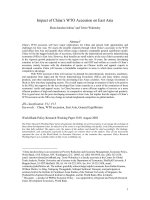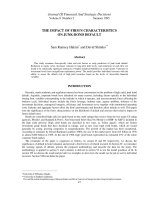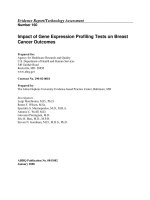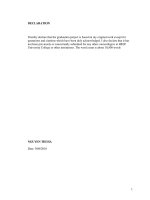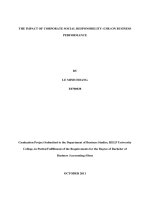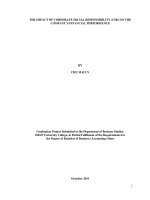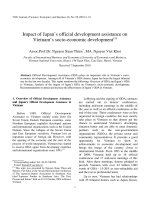Impact of China’s WTO Accession on East Asia
Bạn đang xem bản rút gọn của tài liệu. Xem và tải ngay bản đầy đủ của tài liệu tại đây (244.96 KB, 28 trang )
1
Impact of China’s WTO Accession on East Asia
Elena Ianchovichina
1
and Terrie Walmsley
Abstract
2
China’s WTO accession will have major implications for China and present both opportunities and
challenges for East Asia. We assess the possible channels through which China’s accession to the WTO
could affect East Asia and quantify these effects using a dynamic computable general equilibrium model.
China will be the biggest beneficiary of accession, followed by the industrialized and newly industrializing
economies (NIEs) in East Asia. However, their benefits are small relative to the size of their economies and
to the vigorous growth projected to occur in the region over the next 10 years. By contrast, developing
countries in East Asia are expected to incur small declines in real GDP and welfare as a result of China’s
accession, mainly because with the elimination of quotas on Chinese textile and apparel exports to
developed countries China will become a formidable competitor in areas in which these countries have
comparative advantage.
With WTO accession China will increase its demand for petrochemicals, electronics, machinery,
and equipment from Japan and the Newly Industrializing Economies (NIEs), and farm, timber, energy
products, and other manufactures from the developing East Asian countries. New foreign investment is
likely to flow into these expanding sectors. The overall impact on foreign investment is likely to be positive
in the NIEs, but negative for the less developed East Asian countries as a result of the contraction of these
economies’ textile and apparel sector. As China becomes a more efficient supplier of services or a more
efficient producer of high-end manufactures, its comparative advantage will shift into higher-end products.
This is good news for the poor developing economies in East Asia, but implies that the impact of China’s
WTO accession on the NIEs may change to include heightened competition in global markets.
JEL classification: F11, F15
Keywords : China, WTO accession, East Asia, General Equilibrium
World Bank Policy Research Working Paper 3109, August 2003
The Policy Research Working Paper Series disseminates the findings of work in progress to encourage the exchange of
ideas about development issues. An objective of the series is to get the findings out quickly, even if the presentations are
less than fully polished. The papers carry the names of the authors and should be cited accordingly. The findings,
interpretations, and conclusions expressed in this paper are entirely those of the authors. They do not necessarily
represent the view of the World Bank, its Executive Directors, or the countries they represent. Policy Research
Working Papers are available online at .
1
Elena Ianchovichina is an economist at Poverty Reduction and Economic Management, Economic Policy,
World Bank, 1818 H Street, NW, Washington, D.C. 20043, tel. (202) 458-8910, fax: (202) 522-2530,
email: Terrie Walmsley is a faculty associate at the Center for Global
Trade Analysis, Purdue University and a lecturer in the Department of Economics, Sheffield University, 9
Mappin Street, S1 4DT Sheffield, UK, tel. 44-114-222-3414, fax: 44-114-222-3458, email:
The authors gratefully acknowledge helpful comments from Kathie Krumm,
William Martin, Lu Ding, Nattapong Thongpakde, Sethaput Suthiwart Narueput, and participants at
seminars held at the Institute for Southeast Asian Studies of the National University of Singapore, the
Thailand Development Research Institute in Bangkok, and the World Bank office in Jakarta.
2
This paper – a product of PREM, Economic Policy – was supported by a Regional and Network Research
Grant, Development Economics, World Bank.
2
1. Introduction
China’s WTO accession will have major implications for China and present both
opportunities and challenges for the East Asian economies. A number of factors highlight
the importance of China’s deeper integration into the world economy. The Chinese
economy is large in absolute terms. Purchasing power measures suggest that China is the
second largest economy in the world, constituting half of the Asian economy and 11
percent of the world economy in 1996 compared to 21 percent for the U.S. (IMF, 1997).
3
China’s trade has grown rapidly with the share of exports almost tripling, and that of
imports more than doubling over the period 1990-1996.
4
In terms of merchandise trade,
last year China ranked as the 7
th
largest exporter and the 8
th
largest importer in the world.
5
Despite the fact that China’s capital account is not fully convertible, China is an
important player, both as a recipient and a lender, in global capital markets. By the mid-
nineties, China had become the second largest host country for foreign direct investment
(FDI) after the U.S.,
6
the 8
th
largest capital supplier in the world and the largest one
among developing countries (World Bank, 1997).
7
Due to capital account restrictions,
China’s absorption of portfolio investment is still limited. However, China’s role as a
capital supplier is likely to expand given continued growth, high saving ratio and the
gradual relaxation of capital controls.
With WTO accession, China will continue the process of opening its markets to other
countries’ exports and improving its business climate. This will lower input and
transaction costs and benefit both China and its trading partners. Increased exports from
China to the region will also lower the import prices of its trading partners and improve
their competitiveness. However, accession will also present challenges. Countries that
produce similar products will face increased competition for market share in third
markets. Accession is likely to increase China’s attractiveness as a destination for foreign
investment, leading to concerns that investment may be diverted away from other
countries in the region towards China.
The complexity of the anticipated changes in China, the lack of clarity as to what the
counterfactual is, and the uncertainty associated with the policy response in China and
elsewhere
8
make the task of assessing the impact of China’s WTO accession on the East
3
If measured at 2001 exchange rates China is important, but not dominant. Its current income is 9 times
smaller than the US GDP and accounts for only 3.7 percent of world GDP and 4.4 percent of total trade
(Source: World Bank).
4
The rapid increase in China’s exports occurred over two stages – with the initial opening (1980-1985),
when trade grew faster than GDP, the trade share increased from 0.7% to 2% of world trade, and with trade
reform after 1987, when both trade and GDP grew and the trade share rose to 4 % in 2000. China’s trade
performance over the period 1970-2000 is consistent with the performance of other Asian economies
(Source: Goldman Sachs Research).
5
Source: Customs General Administration, People’s Republic of China.
6
It is difficult to judge the accuracy of the FDI data as they reflect ‘round-tripping’ investments undertaken
from China to take advantage of concessions enjoyed only by foreign investors.
7
These outflows do not include flows through Hong Kong (China).
8
The outcome in other East Asian countries will depend to a large degree on the trade and investment
policies adopted by these countries in response to the post-accession changes in China.
3
Asian economies a challenging one. Thus, our primary objective is to provide a
systematic discussion of the main channels by which China’s WTO accession will have
an impact on regional economies, and then provide initial quantitative assessment of the
impact using a multi-region dynamic general equilibrium framework.
This approach is well-suited for the problem at hand since it offers a systematic way for
determining the likely pattern of changes in factor and commodity prices, and production
around the world in response to an exogenous shock, while taking into account the
complex sectoral and regional linkages over time. The general equilibrium approach has
been used to quantify the impact of China’s WTO accession in a number of studies.
9
Detailed studies focusing on specific sectors and issues have also been conducted
10
and a
number of papers have given special attention to the impact of China’s WTO accession
on the countries in East Asia.
11
This paper improves upon the earlier work by taking into account duty drawbacks in
China and Vietnam,
12
constructing a baseline that reflects most recent growth
projections
13
and major trade commitments in the region,
14
using China’s final WTO
offer and recent estimates of nominal rates of protection and subsidies in agriculture,
15
representing the efficiency gains in the automobile sector induced by the WTO reform
9
See Lejour (2000), Fan and Li (2000), Li et al (2000), McKibbin and Tang (2000), Ianchovichina and
Martin (2001, 2003), Wang (2002), Walmsley and Hertel (2001), Walmsley et al. (2001), Deutsche Bank
(2001) (see also Gilbert and Wahl (2000) for a survey).
10
Huang and Rozelle (2002) and Anderson, Huang and Ianchovichina (2003) analyzed agricultural policy
reforms as part of China’s WTO accession and their impact in light of existing distortions to agricultural
incentives in China. Francois and Spinanger (2002) studied the impact of WTO reforms on the automobile
sector, while Pangestu and Mrongowius (2002), Bhattasali (2002), Wenping and Findlay (2002) analyzed
the impact of WTO reforms on China’s telecoms, financial and logistics sectors, respectively. Sicular and
Zhao (2002) and Hussain (2002) focused on labor market issues and the design of safety nets, respectively.
Hertel, Fan and Wang (2002), and Chen and Ravallion (2002) conducted analysis of the impact of WTO
accession on different households and poverty in China. Mattoo (2001) discussed China’s WTO
commitments in the service sectors, Maskus (2001) – the intellectual property rights, and Messerlin (2002)
– the antidumping and safeguard provisions in China’s accession package.
11
See, for example, Lejour (2000), Li et al. (2000), Wang (2001), Ianchovichina and Martin (2001), and
Deutsche Bank (2001).
12
Lejour (2000) acknowledges the importance of duty exemptions, but implements them as simple
proportionate cuts in tariffs across all sectors and as duty exemptions on imports used in production, instead
of exemption on imports used in the production of exports. This introduces bias in his results.
13
Source: World Bank.
14
These include the Uruguay Round, the Agreement on Textiles and Clothing, AFTA, and the reform in
China prior to 2001. Ianchovichina and Martin (2001) incorporate duty exemptions on imports used in the
production of exports, but ignore the impact of AFTA in the baseline.
15
Lejour (2000) assumed a simple 50% cut in all tariffs that introduced distortions into the sectoral
liberalization story. It is also misleading to compare statutory tariffs and post-accession rates in order to
assess the extent of liberalization in agriculture as part of China’s WTO accession. Recent research (Huang
and Rozelle, 2002) reveals that nominal protection rates on important agricultural commodities (rice,
vegetables and fruits, livestock and meat) were negative in 2001 and are likely to remain unchanged in the
post-accession period. Consequently, the reduction in agricultural protection is likely to be far less than
presented in earlier studies. Nonetheless, greater scope for imports in China are likely for a range of
agricultural products (wheat, oilseeds, sugar and dairy products) that are protected mainly by tariffs,
scheduled to be reduced substantially, and cotton and feedgrains, where export subsidies are ruled out.
These important findings are not incorporated in earlier studies.
4
process,
16
and liberalization in cross-border trade in services.
17
Throughout the paper we
compare and supplement our findings with results from this literature. We extend the
literature by looking at the impact of accession induced technological change in China on
the East Asian region.
The paper is organized as follows. Section 2 provides a qualitative analysis of the impact
of WTO accession on East Asia. Section 3 discusses the methodology and simulation
design and provides a quantitative assessment of the impact of accession on individual
country’s output, exports, investment flows and welfare. Section 4 discusses the impact
of accession induced productivity gains in China on the countries in East Asia. Section 5
offers some concluding remarks.
2. Impact of WTO Accession on East Asia: A Qualitative Assessment
We identify several main channels through which China’s WTO accession will affect the
economies in East Asia: (1) increased access to China’s domestic market; (2) improved
competitiveness; (3) competition with China in third markets; (4) expansion of foreign
investment in China and, potentially, outward foreign investment from China; (5)
transparency and predictability of trade policy; (6) entry of a major developing country to
the WTO.
Increased access to China’s large market
China has been a powerful driver of growth in East Asia – spurring growth not only in
the newly industrialized economies, but also in the developing countries of East Asia. In
1997, more than 60 percent of China’s imports were sourced from other countries in East
Asia.
18
In the nineties, ASEAN countries’ exports to China grew by 390 percent and
these countries’ share in China’s total imports rose from a little below 6 percent in 1990
to 9 percent in 1999.
19
Looking ahead, China is expected to continue to be a driver of growth in East Asia as it
becomes a much bigger market for its trading partners following accession to the WTO.
20
In many sectors China’s WTO accession only adds a little to the already vigorously
projected growth of these markets.
21
Nevertheless, accession will lead to significant
changes. In services, China has made commitments to provide national treatment to
16
Francois and Spinanger (2002) estimate that tariff reform as part of WTO accession could generate as
much as a 20 percent increase in total factor productivity in the automobile sector affecting particularly
assembly operations. None of the studies looking at the regional impact of China’s WTO accession
consider the reform-induced restructuring of the automobile sector.
17
The method adopted here follows Francois and Spinanger (2002). Most studies have abstracted from the
impact of China’s WTO accession on cross-border trade in services.
18
Source: Version 5 GTAP data (Dimaranan and McDougall, 2002).
19
Source: UN Comtrade System.
20
With assumptions of higher growth rate in China than in other developing countries, China’s share of
world trade is expected to double by 2007 and surpass that of Japan, but be still much lower than that of US
and the EU (Ianchovichina and Martin, 2003).
21
Growth in China has been fueled by years of serious economic reform. See Tables 5, A.5, and A.6 in
Ianchovichina and Martin (2003).
5
foreign-funded firms and greater opportunities for exporters of services.
22
In
manufactures, China has committed to abolish non-tariff barriers and reduce tariffs from
13.3 percent in 2001 to 6.8 percent
23
by the end of the implementation period. In
agriculture, China’s imports are projected to grow, though this growth is much smaller
than projected in earlier studies since protection on many farm products is expected to
remain virtually unchanged by the end of the implementation period (Huang and Rozelle,
2002).
Growth in the region will also be stimulated by increased demand in China’s major
trading partners that benefit directly from China’s accession. Therefore, the East Asian
developing countries will export more not only to China, but also to Japan, Tawain
(China) and the rest of the Newly Industrializing Economies (NIEs). Both the direct and
indirect effects of increased access to China’s markets will be important determinants of
regional trade.
Improved competitiveness
China’s accession to the WTO will be accompanied by a reduction in protection that will
lower its export prices and increase China’s appeal as an efficient supplier. China’s pre-
accession reforms have already improved the competitiveness of Chinese exports and
have benefited its closest trading partners. Trade intensity indexes for 1985 and 2001
suggest that trade between China and individual East Asian economies has intensified
sharply since 1985 (Ng and Yeats, 2002). Thus, most East Asian economies are expected
to benefit from further cuts in export prices as China continues to implement WTO
related reform over the next few years. The benefits to these countries will be both in
terms of increased output and welfare as these countries source cheaper imports from
China and use them as intermediate inputs in their production processes. However, to
realize these benefits, countries will have to resist protectionist pressures, which have
been growing in a number of countries.
Increased competition in third markets
Competition with China in third markets will intensify as a result of China’s accession to
the WTO. This will present a challenge for many countries, especially those that have
similar comparative advantage in labor intensive goods.
South East Asia competes with China in world markets for manufactures, especially labor
intensive products, and increasingly higher value added products, such as semi
conductors and other high technology products. Competition has led to unit price
declines, but thus far other developing East Asian exporters have maintained their market
shares in the US and Japan.
24
The aggregate picture, however, hides the story for
22
These commitments represent the most significant part of China’s accession package (Mattoo, 2001).
23
These are weighted average tariffs computed using trade weights for 2001 (see Ianchovichina and
Martin, 2003).
24
In the U.S., China and ASEAN gained market share at the expense of Japan, Tawain (China), and Korea.
In Japan, China and ASEAN captured market share at the expense of the U.S. and Japanese firms (Andy
Xie, Morgan Stanley Research, 2002).
6
individual sectors. ASEAN maintained market share for textiles and apparel in the quota-
constrained US market, albeit at the expense of falling unit prices. However the South
East Asian countries lost market share in textiles and apparel in Japan, where China’s
exports of textiles and apparel are not quota constrained.
A number of reasons suggest that competition will intensify with China’s WTO
accession. Accession will lead to the abolition of quotas on Chinese textiles and apparel
exports to the US and the EU in 2005.
25
This implies that China will become a
formidable competitor especially in the apparel market.
26
The effect of tariff reductions
on the real exchange rate will lower the costs of both trade and non-traded inputs for
China’s manufactures. This will make China’s products more competitive, putting
pressure on the price of competing products elsewhere. China has a vast labor force,
including a large stock of underemployed agricultural workers, spread over vast
geographical areas that differ in stages of economic development. China also has much
lower labor cost per unit of output, not only relative to developed countries, but also
compared to most developing countries. This suggests that cheap labor supply will last
for a long time regardless of China’s rate of growth (Wang, 2002).
Changes in Investment Patterns
WTO accession will increase foreign investment in China as trade liberalization lowers
production costs and the price of capital goods, and increases the rental rates, resulting in
rising returns to capital in China.
27
WTO accession will ensure that China adheres to the
general principle of non-discrimination (Bhattasali et al., 2002), which will boost
investment as it implies lower transaction costs, increased imports, and increased sales
and profits of foreign invested companies. Meanwhile, the liberalization of rules on
investment should ease flows of FDI into previously restricted sectors such as services.
China’s accession is also likely to set off changes in regional trade and production
patterns whose effects will be felt over the longer term. The issue for other East Asian
economies is whether their own foreign investment inflows will increase or decrease as a
result. It is difficult to answer this question since much will depend on the policy
responses of individual countries. In addition, a number of factors will work
simultaneously to determine the net regional impact of China’s WTO accession on
investment flows. While countries that lose competitiveness may see declining returns to
capital and foreign investment diverted to China, several effects are likely to counteract
this negative impact on foreign investment.
Whereas in the past China used to draw heavily on the overseas Chinese community as a
source of FDI, with accession China will be able to draw on the global capital markets
25
China will be subject to additional textile safeguard quotas until 2007, but these will be applicable for
only one year at a time, unlike the existing quotas which were put in place for an indefinite period of time.
26
This is a consensus finding supported by Ianchovichina and Martin (2001, 2003), Deutsche Bank (2001),
and Wang (2002).
27
McKibbin and Tang (2000) and Walmsley, Hertel and Ianchovichina. (2002) discuss in detail the effect
of trade and financial reform in China on rates of return to capital and foreign investment.
7
both for FDI and portfolio investment. Thus, competition between China and other
countries in East Asia for FDI may actually weaken.
Increased productivity and trade liberalization in China both increase the country’s
demand for imports and raise investment and welfare in China’s trading partners. Martin
(1993) shows that a productivity shock in manufactures and services, for which there is a
lot of two-way trade, is more likely to raise welfare in country’s trading partners than is
trade liberalization. Given the substantial productivity gap that exists between local and
foreign firms, the new FDI flows are very likely to raise China’s productivity. In apparel
and footwear (textiles), for example, the adoption of foreign technology raises
productivity by 30 - 62 % in collective enterprises and 20 - 59 % in state enterprises
(Claro, 2001). This implies that the technological advance accompanying China’s WTO
accession will improve the country’s competitiveness, increase the country’s demand for
imports, and perhaps raise investment levels in countries supplying these imports.
Investment liberalization in China will make it possible for multinational firms to further
rationalize their production processes within East Asia. The relief of local content
requirements under Trade-Related Investment Measures (TRIMs) will encourage these
firms to relocate some segments of their production from China to other countries in the
region. In some sectors, China’s neighbors may receive FDI flows that complement those
going to China. The scope for export specialization will vary with the degree of
complementarity between China and other countries of East Asia. Its current comparative
advantage in labor-intensive products suggests that there is more scope for export
specialization vis a vis the newly industrializing economies than vis a vis the developing
East Asian countries.
As FDI strengthens the linkages among industries in a region, the competitiveness of
Asian products will depend not only on the competitiveness of the country that exports
the final product, but also on those neighboring countries that contribute various
components at different stages of the production process. This will create an incentive to
direct investment to different countries that are part of the regional production networks.
Finally, the determinants of FDI are evolving over time. Agglomeration effects are
becoming more important relative to traditional determinants of FDI such as market size
and labor costs (UNCTAD, 2002). China’s comparative advantage may also change
appreciably after WTO accession.
28
Over time, China is also likely to shift and extend its
comparative advantage into higher-end products as the result of trade-induced
productivity gains
29
and savings in transaction costs from the reforms spurred by WTO
accession. This implies that the impact of China’s WTO accession on the NIEs may
change to include heightened competition in global markets.
28
All East Asian economies saw increases in the share of manufactured exports during the first half of the
1990s and changes in the structure of manufactured exports. In the 1990s, the NIEs increased their share of
electronics and information technology products and China increased its share of electronics and
telecommunications exports.
29
This issue is explored in section 4.
8
Transparency and predictability of trade policy
China’s trading partners are going to benefit from the increased transparency and
predictability of trade policy as China follows general WTO policy rules and a number of
specific commitments (Bhattasali et al., 2002). The general WTO policy rules include
among other things the need to publish trade rules and regulations. The specific
commitments involve uniform application of the trade regime, independent judicial
review and a mechanism to bring problems of local protectionism to the attention of the
central government. This means that access to China’s market will be secured and
disputes will be resolved following international standards. This will be an important
benefit to China’s trading partners.
Entry of a major developing country to the WTO
China could share its experience in the design of institutions that work effectively in low-
income developing countries (Martin and Ianchovichina, 2001). This will help countries
in the region that are not yet WTO members but are planning to join the organization to
avoid problems from adoption of practices that work well in a developed country context,
but not in a developing country context (Finger and Schuler, 2000). In addition, China
has a wide range of market access interests. Just like other developing countries, it faces
relatively high tariff barriers in quite a wide range of export products, such as textiles and
clothing, and agricultural exports. After accession to the WTO, the developing economies
in East Asia and elsewhere could gain from cooperation with China to reduce these
barriers.
3. Impact of WTO Accession on East Asia: A Dynamic Computable General
Equilibrium Analysis
The discussion above suggests that the effects of China’s WTO accession will be mixed.
Some of these effects will be unequivocally positive or negative for all countries in East
Asia. Others will differ in their impact depending on the countries’ stage of development,
current trade patterns, the degree to which countries can alter their import mix and the
mix of domestic and imported products, and their comparative advantages.
30
To discern
the likely impact of China’s WTO accession on other East Asian economies and quantify
these effects we conduct analysis using a dynamic general equilibrium approach.
Methodology
The general equilibrium modeling provides the framework for a comprehensive
assessment of the reform process in China in a global context. The analysis relies on the
dynamic version of GTAP (GTAP-Dyn), a global general equilibrium model,
31
modified
to capture duty exemptions for imports used in the production of exports in China and
30
The impact will also depend on the policy response in China and rest of East Asia. However, we do not
consider such alternative policies here.
31
Hertel (1997) discusses the GTAP model and data, while Ianchovichina and McDougall (2001)
document its dynamic version.
9
Vietnam.
32
These export processing arrangements are important for the analysis since
they imply that the economies of China and Vietnam are much more open then suggested
by statutory tariff rates. This in turn implies a much smaller impact of WTO accession on
the Chinese and other economies than found by studies that ignore duty drawbacks.
The dynamic GTAP model has a sophisticated representation of consumer demands via a
constant difference of elasticities (CDE) functional form and a supply side that
emphasizes the role of intersectoral factor mobility in the determination of industry
output. Product differentiation between imports and domestic goods, and imports by
region of origin allows for two-way trade in each product category, depending on the
ease of substitution between products from different regions. In each region, a single
regional household allocates income from land, skilled and unskilled labor, financial
assets, and a natural resource endowment across private and government consumption,
and saving according to a Cobb Douglas utility function. Firms supply commodities to
both the domestic and export markets, while minimizing production costs.
The investment theory in the model allows us to link economic activity over time while
keeping track of endogenous regional capital stocks and financial wealth,
33
international
investment and income flows. The theory respects the empirical regularity that regions
tend to invest primarily in assets located in their domestic economy. A smaller portion of
investment comes from abroad and the theory offers a disequilibrium approach for
allocating this investment across regions. Investors respond to expected rates of return
and act so as to eliminate errors in their expectations gradually over time. In the process
of adjustment, investors gradually eliminate any differences in the rates of return across
regions that might exist in the short run by reallocating capital from regions with lower
rates of return to regions with higher rates of return.
34
This leads to equalization of rates
of return across regions only in the long run.
35
Financial assets represent claims on earnings from regional physical capital, which is
owned by both domestic and foreign households via a global trust.
36
In the model, the
32
The GTAP model with duty drawbacks is presented in Ianchovichina (2003).
33
Unlike capital, land, labor and the natural resource endowment are exogenous. All factor inputs are fully
employed, immobile across regions, and with the exception of land and the natural resource input, are
perfectly mobile across sectors. The model captures how differences in relative rates of factor accumulation
interact with differential sector intensities giving rise to the so-called ‘Rybczynski’ effect.
34
This way of determining changes in FDI flows captures only the substitution effect of allocating FDI, i.e.
the relocation of incremental FDI from regions with falling rates of return to regions with rising rates of
return.
35
The disequilibrium approach is also necessary to reconcile the theory of investment with observed
reality. In many cases actual investment, as reported in the national statistics, does not correspond to that
predicted by theory. For example, observed rates of return may be very low while observed investment is
high. Such discrepancies can be rectified in one of two ways: the data can be altered so that theory and data
are consistent; or alternatively, the theory can be modified to more accurately reflect the world. In GTAP-
Dyn the latter method is used.
36
The global trust collects all the regional saving allocated to foreign investment, then allocates it across
regions to investment. It is a fictitious agent invented to simplify the need for data in the global model.
Without the global trust a region’s saving would need to be allocated directly to foreign investment by
region. As a result bilateral data on foreign investment would be required (nxn data values, where n equals
10
allocation of investment assumes that the shares of domestic and foreign investments are
held constant, subject to the adding-up constraints required to ensure regional saving and
investment constraints. Explicit modeling of the ownership of regional investment allows
us to track the accumulation of wealth by foreigners, thereby ascertaining how China’s
accession to the WTO might affect foreign investment and ownership in each region.
Moreover, the income accruing from the foreign and domestic ownership of assets can
then be appropriately incorporated into regional income, and hence into the calculation of
welfare, for both China and all other regions.
Table 1. China’s Average Tariff Rates (%)
Sectors 1997 1998 1999 2000 2001 2002 2003 2004 2005 2006
2007-
2010
Food grains
10.6 9.8 9.1 8.3 7.6 7.6 7.6 7.6 7.6 7.6 7.6
Feed grains
28.0 29.0 30.0 31.0 32.0 32.0 32.0 32.0 32.0 32.0 32.0
Vegetables-fruits-nuts
-8.0 -7.0 -6.0 -5.0 -4.0 -4.0 -4.0 -4.0 -4.0 -4.0 -4.0
Oil seeds
28.0 26.0 24.0 22.0 20.0 17.2 14.3 11.5 8.7 5.8 3.0
Sugar
42.0 41.5 41.0 40.5 40.0 36.7 33.3 30.0 26.7 23.3 20.0
Plant fibers
17.0 17.0 17.0 17.0 17.0 17.5 18.0 18.5 19.0 19.5 20.0
Livestock-Meat-Dairy
-8.9 -8.2 -7.4 -6.7 -5.9 -6.3 -6.6 -6.9 -7.2 -7.5 -7.8
Beverages-tobacco
63.2 58.9 54.5 50.2 44.6 39.9 35.1 30.3 25.5 20.8 16.0
Other food
34.8 35.2 35.5 35.9 35.3 31.0 26.7 22.4 18.1 13.8 9.5
Wood products
10.8 10.5 10.2 9.8 9.5 8.5 7.5 6.5 5.5 4.6 3.6
Extract
0.2 0.3 0.3 0.3 0.5 0.5 0.4 0.4 0.4 0.3 0.3
Textiles
25.1 24.2 23.3 22.4 20.7 18.8 16.8 14.8 12.8 10.8 8.8
Wearing apparel
31.8 30.0 28.2 26.4 23.4 22.0 20.7 19.3 18.0 16.6 15.3
Light manufactures
12.1 12.1 12.1 12.2 11.7 11.1 10.5 9.8 9.2 8.6 8.0
Processing industries
12.0 12.0 12.0 12.0 11.7 10.9 10.1 9.2 8.4 7.6 6.8
Autos
34.4 34.9 35.4 35.8 32.0 29.0 26.0 23.0 20.0 17.0 14.0
Electronics
11.9 11.5 11.0 10.6 10.3 9.0 7.6 6.2 4.8 3.4 2.0
Other manufactures
13.2 13.2 13.2 13.2 12.9 11.9 10.8 9.8 8.7 7.7 6.7
Source: Authors’s calculations based on version 5 GTAP data (www.gtap.org), World Bank, and data from
CDS consulting. These tariff rates are trade weighted, applied, statutory rates..
We use version 5 GTAP database, aggregated into 20-regions and 22-sectors, shown in
Appendix Table A1. The GTAP data base is supplemented with foreign income data from
the IMF Balance of Payments statistics in order to track international capital mobility and
foreign wealth.
We assesses the regional impact of China’s WTO accession against a baseline that
depicts the growth of the world economy over the period 1997-2010,
37
the
implementation of the Uruguay Round (UR), the Agreement on Textiles and Clothing,
AFTA, and the reform in China prior to 2001. The accession scenario represents reform
of China’s agriculture, manufacturing and services. Reform in agriculture includes tariff
the number of regions). The use of the global trust minimizes the data required to regional saving invested
abroad and total foreign investment in each region (2n data values).
37
Appendix Tables A2 and A3 show baseline growth rates for GDP and gross domestic investment (GDI).
11
reform (Table 1) and the removal of export subsidies on feed grains and cotton.
38
Reform
of China’s manufacturing encompasses the removal of quotas on China’s textiles and
apparel exports to the European Union and North America,
39
tariff reform (Table 1) and
the restructuring of China’s automobile sector.
40
Services liberalization represents the
removal of non-tariff barriers on cross-border trade.
41
Impact on Japan and the NIEs in East Asia
China will be the biggest beneficiary of accession to the WTO,
42
gaining around US$ 10
billion
43
or about 1 percent of China’s GDP in 2001.
44
Japan and the newly industrialized
economies in East Asia will also benefit from China’s accession to the WTO (Table
2a).
45
As important suppliers of materials to China, these countries will observe an
improvement in their terms of trade and returns to capital. In both Japan and the NIEs, the
projected increases in production are driven mainly by expansion in exports to China.
While these countries are well positioned to gain from accession, many of the trends from
China’s growing role are already underway.
38
Huang and Rozelle (2002) estimate that subsidies on feed grains and cotton are 32 percent and 10
percent, respectively.
39
Unlike most other developing countries – members of the GATT 1947, China was excluded from the
Uruguay Round Agreement on Textiles and Clothing (ATC). Therefore, China has not benefited from the
increase in quotas provided for under this agreement. This has put pressure on the transaction prices of
these quotas, which are equivalent to an export tax of the same magnitude. In this paper we use estimates of
the 2001 export tax equivalents in Ianchovichina and Martin (2003). In the US the 2001 quotas on Chinese
textiles and apparel were equivalent to an export tax of 11 and 15 percent, respectively, while in the EU
those were 12 and 15 percent, respectively. With accession China will benefit from the abolition of these
quotas by 2005. Based on the experience with ATC under the Uruguay Round of the WTO (Spinanger,
1999), quota removal will be back-loaded with the bulk of the impact not felt until the last two years.
40
The method adopted here follows Francois and Spinanger (2002).
41
Francois and Spinanger (2002) provide estimates of the tariff equivalents of the non-tariff barriers to
cross-border trade in services in China and Tawain (China) before and after accession. From these
estimates cuts in tariff equivalents on direct trade in services are computed as documented in Hertel,
Walmsley, and Itakura (2001). For China, the resulting annual cuts are 0.2 for trade and transport, 0.8 for
communications, 2.2 for commercial services, 1.7 for other services. For Tawain (China), the resulting cuts
are 0.3 for trade and transport, 0.4 for communications, 0.7 for commercial services, and 1.2 for other
services.
42
This result is consistent with findings in Ianchovichina and Martin (2001, 2003) and Wang (2002).
43
These are in 1997 US$. This estimate is conservative since it does not reflect income increases due to
trade-induced productivity gains, and especially gains associated with the liberalization of China’s service
sectors, as well as transaction cost savings. The benefits to China from developing institutions compatible
with an open and modern market could be very large as well, but were not factored in the analysis.
44
This estimate is in line with estimates in a wide range of studies, including Ianchovichina and Martin
(2003), Li et al. (2000), Wang (2002), Deutsche Bank (2001). Results are sensitive to the values of the
Armington elasticities of substitution, but do not change qualitatively. A fifty percent increase in the values
of these elasticities almost doubles China’s welfare gains from WTO accession, while a fifty percent
reduction in the values of these elasticities reduces the gains to China by a factor of 10.
45
These results from CGE modeling are consistent with findings of other CGE modeling work. See Wang
(2002), Ianchovichina and Martin (2003), Li et al. (2000), Deutsche Bank (2001). We find that Singapore
loses from China’s WTO accession. This finding should be interpreted with some care since our analysis
takes into account only liberalization of cross-border trade in services. If we had taken into account the full
package of reforms affecting China’s services sector, we might have found that Singapore, which is well
positioned to provide financial, communications and other types of services to China’s growing economy,
would gain from accession.
